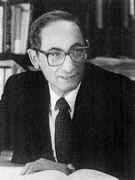Person: Chernoff, Herman

Herman Chernoff is an American mathematician and statistician who worked in sequential analysis and optimal design.
Mathematical Profile (Excerpt):
- Herman attended junior high school in New York and, because he had shown considerable ability, was invited to sit the competitive examinations to enter Townsend Harris High School.
- After graduating, Chernoff had been intending to study mathematics at graduate level but he received a letter asking him to contribute to the war effort by working as a junior physicist for the U.S. Navy.
- By this time Chernoff had decided that his talents did not lie in applied mathematics but, having seen more statistical applications during his military service, he decided to change topics.
- Wald was at North Carolina and Chernoff prepared by reading papers by Wald on sequential analysis.
- After some hesitation, Wald agreed and so Chernoff's doctoral thesis Asymptotic Studentization in Testing of Hypotheses was supervised by Wald although his official supervisor at Brown University was shown to be James Krumhansl and the degree was awarded by Brown.
- Chernoff was awarded the degree in 1948 and part of his thesis was published as Asymptotic Studentization in testing of hypotheses in 1949.
- In 1949 Chernoff became an Assistant Professor of Mathematics at the University of Illinois at Urbana.
- Although on the faculty at Illinois until 1952, Chernoff went to Stanford University as a visitor from June 1951 until January 1952, then later that year accepted the position of Associate Professor of Statistics there.
- In 1959 Chernoff, in collaboration with Lincoln E Moses, published a classic text Elementary decision theory.
- In 1972 Chernoff published a monograph which incorporated much of his work over many years.
- A list of other topics treated follows: D-optimality and the Kiefer-Wolfowitz equivalence theorem; hypothesis-testing in a treatment which is largely, although not whole-heartedly, decision-theoretical; the large-sample evaluation of risk in terms of the Chernoff bounds (a term not used in the text) and the various information numbers; optimisation of sample size in the case of low-cost experimentation; the sequential probability ratio test, no-overshoot approximations, optimality; the Chernoff "procedure A" for sequential design, and its asymptotic optimality; adjacent hypotheses, and the Schwarz boundaries; testing for the sign of a normal mean, with a general consideration of dynamic programming ideas, and of helpful asymptotics; some discussion of one- and two-armed bandits.
- In 1974 Chernoff left Stanford University and moved to the Massachusetts Institute of Technology where he was appointed Professor of Applied Mathematics.
- However, Chernoff did not really retire since he was appointed as Professor of Statistics at Harvard University.
- Chernoff has been honoured in many ways for his important contributions.
Born 1 July 1923, New York City, New York, USA.
View full biography at MacTutor
Tags relevant for this person:
Origin Usa
Thank you to the contributors under CC BY-SA 4.0! 

- Github:
-

- non-Github:
- @J-J-O'Connor
- @E-F-Robertson
References
Adapted from other CC BY-SA 4.0 Sources:
- O’Connor, John J; Robertson, Edmund F: MacTutor History of Mathematics Archive
